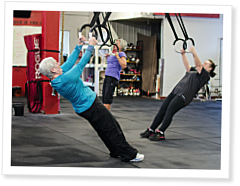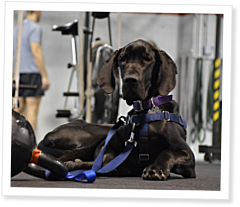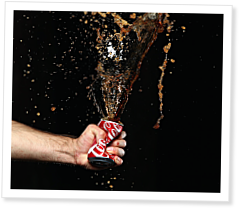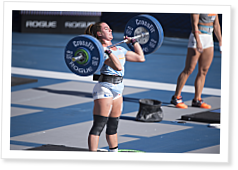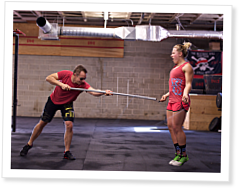Part 3 by Steve Dussia
“As opposed to a set of weights however, with Elmer there were no light and heavy days. Every day was a heavy day, heavier than the day before. Elmer ate like a pig, and Bill kept lifting him, every day, rain or shine, for as many reps as he could muster.”
Read More
var addthis_config = {"data_track_addressbar":true};
Bill’s best friend when he was a child was named Elmer, and a nicer male cow you will never meet. Bill wasn’t writing books at this stage of his life, but one of the ones he read had a story about a guy named Milo of Croton, who, “back in the day” got the bright idea that if he lifted a cow every day, starting when it was a calf, that eventually he would be lifting a full grown cow. Well, thought Bill, we have a calf, so I’d better get started before he gets too big. I guess it goes without saying that Bill spent a number of his formative years living on a farm. Bill was in such a hurry to get started that he neglected to read the part that explained the technique used by Milo. Bill figured that the best way to lift him would be to kneel down, put his arms under Elmer’s stomach, and stand up. As we all know, cows have numerous stomachs, so maybe it would be more accurate to say “midsection.”Elmer was just doing his cow thing, mooing, grazing, chewing his cud, etc., when, out of the corner of his eye, he noticed Little Billy creeping up beside him. Normal life, as Elmer knew it, was about to end that day. Bill’s technique actually worked, and he was on his way to a lifetime consumed with elevating heavy objects. As opposed to a set of weights however, with Elmer there were no light and heavy days. Every day was a heavy day, heavier than the day before. Elmer ate like a pig, and Bill kept lifting him, every day, rain or shine, for as many reps as he could muster. I’m no mathematician, and I know even less about cows, or in this case, a bull, but if he gained 3-4 lbs a day, this program was going to get extremely difficult, and very soon. Considering he was eating bushels of grass every day, either he was going to gain weight like gangbusters, or the footing around him was going to get very slippery, or both. At this point, you’re probably thinking that this story is bullshit. (Pun intended) Lest you think that I’m making it up, this is exactly as Bill related it to me. The program was proceeding as planned until the day Bill showed up for his workout wearing a red shirt. To make a long story short, I think Milo still holds the record, and Bill’s contusions and abrasions healed up just fine. OK, I made that last part up.Bill’s first foray into the field of writing was, as with most people in those days, letter writing. This was in the era of post WWII, and personal computers were the stuff of science fiction. He had access to an old Underwood typewriter, on which he taught himself to type, and as anyone who’s ever had one knows, they could also be used as a fairly substantial weight. Lifting this, and anything else he could find that wasn’t nailed down, along with doing his farm chores, helped him build a base of strength, which he felt he needed for personal defense at school. This was in the days of real bullying, where you got your teeth knocked out, black eyes, bloody noses, and the like. Cyber bullying would have been a welcome relief, but social media in the late 40s and early 50s consisted mainly of disparaging remarks written on restroom walls. He learned how to box, from his brothers, and that helped also, but the desire for progressive resistance training was smoldering within him, even then. Jumping ahead a number of years found him involved with YMCAs, which of course had weights. Weightlifting in those days in small town USA was something you felt you had to apologize for, and the weights were generally a conglomeration of exercise bars, wooden benches and a selection of small-hole plates. There were usually some Indian clubs, which looked like slim bowling pins, and sometimes kettle bell handles that you slid a dumbbell bar through, and added plates. Instead of leg extension and curl machines, you used a pair of iron boots, which also had a hole for a dumbbell bar, and possibly the narrowest, most uncomfortable canvas straps available to hold them on your feet, not to mention the worst designed buckles of all time. Photos in the magazines of the era showed leg curls being performed by standing on one foot, with a broom handle to aid in balancing, and curling a dumbbell with your leg, using a technique not unlike an arm curl. At these moments, you said a silent prayer that no one would pull the fire alarm. Bill was in his glory, using this equipment in the damp dusty basements of these Ys, under the light of a bare bulb, doing exercise routines he read about in Physical Culture Magazine, by the pioneer of weight training publishing, Bernarr McFadden. These magazines were decades out of date, but Bill knew, even then, that he wanted to get to the point where he could put his ideas on paper. He also had access to the York publications, Strength and Health being his favorite, and like many of us in that era, he ordered protein, belts, neck harnesses and the like, building his body, and biding his time. He was entering the world of strength building and healthy lifestyles, long before the terms aerobics, core work, super sets, circuit training, etc. were being touted as the latest greatest things. Bill was old school even before there was an old school. But he was forced to adapt, and dare I say, innovate, as weight training trickled into the mainstream. With the success of each of his trainees, and their trainees, and theirs, he felt that he could finally have an influence on the acceptance of barbell exercises, and their application to a myriad of sports. And through it all, he just kept cranking out the advice on a typewriter that probably has antique value, no, not the Underwood of yesteryear, but a newfangled electric typewriter. He always felt that they should have given him stock in the White Out Corporation, which he admitted probably wasn’t worth much, as everyone else in the civilized world was just hitting the delete button. Bill never made the leap to computers, which makes his volume of work that much more impressive. Editors no doubt rolled their eyes when the envelopes packed with typewritten pages showed up on their desk. When their secretary said, “You’ve got mail”, she meant snail mail, straight from the postman’s bag. At this point the editor would say, sarcastically, “Let me guess…Bill Starr?” Bill went to the Post Office once a week, a routine that he never changed.The closest he ever came to seeing his contributions to Internet publishers in their finished form was when someone mailed a printed copy to him. When I had access to a computer, I would print out as many articles as I could find, and also all the comments, and mail him a copy. He enjoyed them all, and I didn’t edit out any, regardless of the opinions expressed. To paraphrase Henry Ford, Bill’s adage was, “Praise me, or curse me, just be sure to say Bill Starr.” I never found any articles by Bill that suggested cow lifting, but his name is like a rash all over the Web. Well, OK, a good rash. {pagebreak}Bill found, early on, that he was barely out of the gate as a lifter, and people were already hitting him up for advice. They got the benefit of free training tips, and he got free guinea pigs, whose results got filed away, in the recesses of his brain, for future reference. There seems to be an unwritten rule that when you have any degree of success in the weightlifting world, you are required to pass the techniques you used on to others to enhance their abilities. Some think they have better ideas, some do absolutely nothing with them, but every now and then, someone takes them and runs with them. Bill always suggested that, along with subscribing to the theory, you might want to exert some effort. To quote him from a 2011 letter, “…the reason so many people who train are still in miserable shape is they’re lazy. Unwilling to push to the limit. Or train often enough.” If you need someone to interpret that for you, here’s an example…take a weight you can lift 10 times and lift it 20 times. Rest for 30 seconds or so and do another 20. The formula is not magical…the magic has to come from you. Some will say, “That program doesn’t work for me”, and just keep blundering along, looking for the routine that gives amazing results with minimum effort. Let me know how well that works for you.Bill’s persistent vision was an information source that provided the recipe for success, and maybe, somewhere in the back of his mind, he hoped that having it in print might give him a chance to get in a complete workout of his own, now and then. When that never happened, I suggested he include a chapter on how to psych up for a maximum lift, while reviewing a training program that just couldn’t wait. He didn’t have a title in mind in those early days, but the material that became The Strongest Shall Survive was accumulating. It’s certainly possible that Charles Darwin had some indirect input on the title.Bill used numerous points of reference for the material in his books and articles, but it would be unfair to leave out the name of Doug Hepburn, when talking about contributors of strength training methods. He hailed from Canada, and in the early 50s he had few peers. His programs, which he used to become the top heavyweight Olympic lifter in the world, were simplistic on the surface, but were the result of much experimentation and thought on his part, and are the basis for almost all Olympic lifting training to this day, and certainly influenced the training of many of the lifters in that time period. Hepburn’s records of the time were set with no anabolic use, and some of his lifting feats would be difficult for anyone to duplicate. He could military press 400 up to eye level, hold it there for 10 seconds, and then press it to lockout. Photos in old Strength and Health magazines show him holding a 45 lb Olympic plate at arms length in front of him, with only his little finger hooked into the lip of the plate. He had a special ring with a chain welded to it, and with this he held 90 lbs. straight out in front of him for 10 seconds, also from his little finger. (Seems like he did a lot of exercises for 10 seconds.)To fully appreciate this, hold a 90 lb dumbbell at arms length straight out in front of you, using your whole hand. (or for that matter, both hands). He is also credited with seesaw pressing (alternating hands) 100 lb dumbbells for 22 reps each hand. His numerous feats of strength are a part of weightlifting history, and make for some interesting reading. On page 70 of The Strongest Shall Survive, Bill acknowledges Hepburn as the innovator of some of the best routines for building strength. His influence on SSS was significant.Bill’s entry into the publishing world, York publications to start with, helped to fill the gap in the knowledge that he needed to even consider publishing something of his own. Patience and persistence were the keywords in the process, as it was years getting to this point, and more years before the first copy of the first printing saw the light of day. In the interim, he got to write training articles for the magazine, where he honed his ability to convert verbal instructions into print. And even though he was college educated, with a Masters degree, he had a knack for being able to write easily understandable articles. And when trainees following these programs bore fruit, in terms of producing results, well, that didn’t hurt either. Their feedback, detailing the successes and failures they experienced, all got filed into the memory bank. Suggestions were also offered, and they were considered, not just by their source, but also by their potential benefits. Success, in spite of what you are doing, is not as valuable a lesson as failure, in spite of what you are doing. The path to the best methods may not always be a straight line.US Olympic lifting had been on a somewhat protracted downswing by the time Bill arrived in York, at least as it related to the ComBloc countries. The US, once a power in the overhead-lifting world was now playing second fiddle to the state-sponsored steroid programs of Eastern Europe. York, as the hub of the US weightlifting world, was one of the first to learn of this development, and had no intention of letting this happen without responding, and Hoffman saw it as a way to add to the York Barbell’s list of Senior National team titles. That kind of notoriety couldn’t help but add to the sales of York products. As a result, Bill, upon his arrival at the York Barbell, was instructed to go to the York Pharmacy to pick up his “package.” Certainly a somewhat less scientific approach than was probably being used by the Russians, Bulgarians, et al, but with a little word-of-mouth instruction and a month or so of pill popping, it became obvious that they were definitely on to something. The York lifters had been showing amazing improvement for a while now, and the glowing reports were printed in the magazine. No mention was ever made of the pills, but Hoffman had a warehouse full of power racks that needed homes. Articles showed up in the magazine touting the use of power racks in a study conducted by Dr. Ziegler, using Bill March, and showing how isometric “holds” in the rack were responsible for his rapid improvement. From a business standpoint, the strategy worked, as power racks were flying off the shelves, and instead of lifting weights, the gullible buying public was pushing and pulling on an immovable bar. Bill himself had previously followed this routine faithfully, and after showing no improvement, figured he might have read the instructions wrong. Not really, he just hadn’t read between the lines.The good news for those who purchased the racks was that now they had a safe way to bench and squat alone. The bad news was that they were benching and squatting the same amount as before the rack showed up. Not to diminish the value of isometric holds, but they should be viewed as a supplement to weight training, not as a substitute. Tommy Suggs and Bill had an innate sense of fairness about them, and felt that unfair advantage was being taken of the lifters who did not have access to this treasure trove of pharmaceuticals. Dr. Ziegler, who himself worked with CIBA on the development of Dianabol, was disappointed with the fact that lifters had found a way to abuse this drug, and others like it. Gee, imagine that, a prescription drug being used for other than its intended purpose. Letting the cat out of the bag only becomes a relevant cliché when you try to put the cat back in the bag. Well, Tommy and Bill had a suspicion that this cat wasn’t going back in, and they were right. Now it seemed like the fair thing to do was to let other lifters in on the secret. Hoffman’s “advantage” was about to go out the window, a situation of which he was blissfully unaware.{pagebreak}When the York lifters, Bill among them, traveled to meets, lifters anxious to purchase whatever the York guys had brought surrounded them. This generally included protein powder, t-shirts, energy bars, and the like. What the guys didn’t bring was the magic potion, but all the conversations went straight to that. None of the horror stories that you hear today had reared their ugly heads, and it’s unlikely that they would have been a discouraging factor anyway. When lifters heard that the simple act of taking a pill could increase their lifts by 10, 15, or even 20 percent, they were all on board. Sharing this information was a double-edged sword for Bill, as he was in the heyday of his lifting career, and many of the beneficiaries of said info were his direct competitors. At Bill’s invitation, many of these lifters appeared at the York sessions, and in return for his hospitality, he got to pick their brains for training concepts. The one thing that they had in common was that they all trained differently. Bill’s mind was always at work, devising ways to stay highly competitive with them, while sifting through the best of the best routines for his future publications. The bottom line is that Bill was in a constant learning mode, as well as being a teacher. He and Tommy Suggs played a large role in the application of weightlifting methodology to sports, culminating in what you see today in all fields of athletics. I always felt that The Strongest Shall Survive: Strength Training for Football may have been passed over in its early existence by athletes in other sports, who may have felt that resistance training for football was somehow unrelated to their field of endeavor. Maybe Strength Training for Athletics would have been a more appropriate subtitle, at least from the standpoint of commercial acceptance. Regardless, over the decades, it has been alternately devoured, digested, regurgitated, second-guessed, adapted, discussed, and/or applied by those seeking to rise to the top of their chosen sport. It has certainly inspired others to create training regimens, and to publish everything from pamphlets to volumes explaining why their method is the best. Some have gone so far as to create “sports” designed to demonstrate the effectiveness of their methods. I’m fairly certain that Bill never jumped up onto a box intentionally, or threw a medicine ball over a 2-story building. He was a lifter, pure and simple, providing strength-training programs through his publications and articles. His philosophy was equally simple. You brought the motivation, he supplied the formula. Anyone with more than a single digit IQ could comprehend his instructions. You either got stronger, weaker, or stayed the same…your choice.In the role of teacher, Bill would be invited to conduct seminars of sorts for some pretty diverse groups. One such event took us to the Jarrett School in Honolulu to give an Olympic lift, power lift and arm wrestling demonstration. The power lifting and arm wrestling went off without a hitch, but the Olympic lift portion turned into a demo of a different kind, as in demolition. I had just started training with Bill, and had only been converted from the split to the squat-style clean a few weeks prior. I was clean and jerking just over 300 at the time. We had showed up with a bench, an Olympic bar and 6-45 lb iron plates. Everything was fine until Bill suggested that I attempt a personal record clean and jerk of 315. This was in a classroom, with a bunch of little 8 or 9-year-old kids sitting at their desks, and the bar was where the teacher’s desk would normally be. We tried to make it as entertaining as possible. We were making quite a scene; I was pacing back and forth, clapping my chalk-covered hands, which created huge clouds of dust, psyching up by slapping myself in the face and sniffing ammonia inhalants, while Bill was pacing right along with me, yelling encouragement at the top of his lungs. If you Google “the Bushwhackers,” you might get a feel for our presentation. It was weightlifting theater at its worst. We thought that the kids might enjoy the embellishment, but, in retrospect, we may have overdone it. The clean was hard, and the jerk was even harder, possibly due to the fact that I had to take a 90 lb jump from 225, and the floor was freshly waxed. Instead of the perfect storm, it was the perfect earthquake. My feet slipped, I staggered around a little, dropped the bar from overhead, and it pulverized the floor tiles, mere feet from the front row of desks. Kids started screaming and crying, teachers came running in from other rooms, and it probably would have been bedlam but for the fact that now we were just standing there, and the loaded bar was on the floor. Maybe slightly in the floor would be more accurate.Bill, with a totally straight face, said, “So Big, do you want to try that again?” I said, “Sure, but you might want to move the desks back a little.” As I recall, that plan was immediately vetoed, and we never got invited back there again. To this day, I’m not sure why we were performing for a bunch of grade schoolers, but I do remember that the teacher was about Bill’s age and rather cute. It’s quite possible that he had a hidden agenda. We were so busy leaving that I think he forgot to ask her out. She did send us a thank you note at a later date, but that was probably just a formality. We had much better luck with other seminars, but that was our most memorable. I should add that Bill was laughing so hard as we were driving home, that he had to stop the car. The more we thought about it, the harder we laughed, and Bill kept saying, “I can’t believe that just happened.” Bill and I had a deep appreciation for the absurd, and that debacle certainly qualified. I can honestly say that I never knew Bill to criticize the reams of literature, actually libraries of literature, relating to the pursuit of strength and fitness that others have presented. He understood that very few people actually followed his or anyone’s routines to the letter. I think the fact that his programs were most times beneficial, and sometimes thought provoking, is a testament to his plan. He made some people think, and at the same time, provided a road map of sorts to others, who validated his methods with their results. Mark Rippetoe and I, in a recent phone conversation, talked about how, if you scrutinized Bill’s articles over the years, you may encounter some redundancy. After all, how much can you say about a handful of lifts, most of which take only a few seconds to perform? It made me think back to the day when we broke open the first box of The Strongest Shall Survive, about 40 years ago. There were people born that day who have grandchildren now. (I was actually feeling pretty young until I re-read that last sentence.) If their children, or their grandchildren, at some point, derive some benefit from the rehashing of old ideas, I guess it will have been worth it. From my conversations with Mark, I feel that he and I respected Bill as much as anyone. Bill fought a lifelong uphill battle with Athletic Directors and individual sport coaches, who oftentimes felt that he was trying to steal their thunder. He remarked to me over the years about college coaches who said that he stressed strength too much, while at the same time they jumped on every new gimmicky method of off-season training. Maybe if he had worn a tweed jacket and smoked a briar pipe, the education that he was offering would have seemed more palatable to them. I’m sure that he was vindicated many times when super-strong athletes following his recipes, met with theirs on the field of play. More often than not, the Strongest indeed, Survive. On April 7, 2015, Bill and Elmer were reunited in that pasture in the sky. Elmer was just doing his cow thing, mooing, grazing, chewing his cud, etc. when, out of the corner of his eye, he noticed Bill creeping up beside him…
Part 1 Part 2 ::


